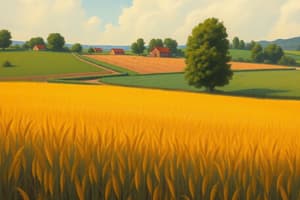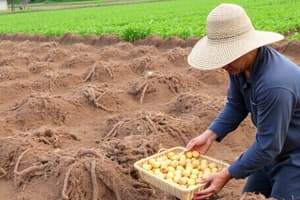Podcast
Questions and Answers
What does agriculture involve?
What does agriculture involve?
- Exploring space
- Mining for resources
- Manufacturing goods
- Cultivating plants and livestock. (correct)
Where is the first known site of agriculture?
Where is the first known site of agriculture?
- The Sahara Desert
- The Amazon Rainforest
- Antarctica
- The Fertile Crescent (correct)
What was a key characteristic of the Green Revolution?
What was a key characteristic of the Green Revolution?
- Introduction of low-yielding crops
- Reduced irrigation infrastructure
- Decreased food production
- Increased use of fertilizers (correct)
What does subsistence farming primarily focus on?
What does subsistence farming primarily focus on?
Which of the following is a crucial aspect of crop production?
Which of the following is a crucial aspect of crop production?
What is the purpose of breeding programs in animal husbandry?
What is the purpose of breeding programs in animal husbandry?
What is soil texture?
What is soil texture?
What is the definition of soil erosion?
What is the definition of soil erosion?
What is the purpose of irrigation in agriculture?
What is the purpose of irrigation in agriculture?
Which type of fertilizer primarily supports leaf growth?
Which type of fertilizer primarily supports leaf growth?
What does integrated pest management (IPM) combine to control pests and diseases?
What does integrated pest management (IPM) combine to control pests and diseases?
What primarily determines the prices of agricultural products?
What primarily determines the prices of agricultural products?
Which of these is a goal of sustainable agriculture?
Which of these is a goal of sustainable agriculture?
What can GPS and GIS be used for in precision agriculture?
What can GPS and GIS be used for in precision agriculture?
Which of the following is a current issue affecting agricultural production?
Which of the following is a current issue affecting agricultural production?
What is the purpose of crop rotation?
What is the purpose of crop rotation?
Flashcards
What is Agriculture?
What is Agriculture?
The science and art of cultivating plants and livestock, including preparing and distributing products.
What is the Fertile Crescent?
What is the Fertile Crescent?
The first known site of agriculture, where early farmers cultivated wheat and domesticated animals.
What is the Green Revolution?
What is the Green Revolution?
A period of agricultural transformation that introduced high-yielding crops and increased use of fertilizers and pesticides.
What is Subsistence Farming?
What is Subsistence Farming?
Signup and view all the flashcards
What is Commercial Farming?
What is Commercial Farming?
Signup and view all the flashcards
What is Irrigation?
What is Irrigation?
Signup and view all the flashcards
What is Animal Husbandry?
What is Animal Husbandry?
Signup and view all the flashcards
What is Soil Fertility?
What is Soil Fertility?
Signup and view all the flashcards
Irrigation
Irrigation
Signup and view all the flashcards
Fertilizers
Fertilizers
Signup and view all the flashcards
Pests
Pests
Signup and view all the flashcards
Agricultural Economics
Agricultural Economics
Signup and view all the flashcards
Sustainable Agriculture
Sustainable Agriculture
Signup and view all the flashcards
Agricultural Technology
Agricultural Technology
Signup and view all the flashcards
Integrated pest management (IPM)
Integrated pest management (IPM)
Signup and view all the flashcards
Current Issues in Agriculture
Current Issues in Agriculture
Signup and view all the flashcards
Study Notes
- Agriculture involves both the science and art of cultivating plants and livestock.
- It includes preparing plant and animal products for use and distributing them.
History of Agriculture
- Agriculture emerged independently across various regions globally.
- The Fertile Crescent marks the earliest known agricultural site.
- Emmer and einkorn wheat were among the first cultivated plants.
- Early farmers domesticated goats and sheep.
- Agriculture facilitated settled communities and the rise of civilizations.
The Green Revolution
- The Green Revolution was a transformative period in agriculture.
- High-yielding crop varieties were introduced.
- Irrigation infrastructure was developed and expanded.
- Fertilizer and pesticide use increased.
- Food production saw significant increases due to these practices.
- It had negative environmental and social consequences.
Farming Systems
- Subsistence farming focuses on growing crops and raising livestock.
- Production is primarily for the farmer's family consumption.
- Commercial farming focuses on growing crops and raising livestock for sale.
- Intensive farming maximizes yields using high levels of inputs.
- Extensive farming uses few inputs over a large area.
- Organic farming relies on natural methods, avoiding synthetic inputs.
Crop Production
- Soil preparation is crucial for successful crop production.
- Seeds are sown or planted in prepared soil.
- Irrigation provides water necessary for plant growth.
- Fertilizers provide essential nutrients to plants.
- Pest and disease management protects crops from damage.
- Harvesting involves gathering mature crops.
- Post-harvest handling readies crops for storage or sale.
Animal Husbandry
- Animal husbandry focuses on breeding and raising livestock.
- Proper housing and feeding are important for animal health.
- Disease prevention and treatment are necessary aspects.
- Breeding programs improve animal productivity.
- Dairy farming involves raising cows for milk production.
- Poultry farming involves raising chickens, turkeys, and other birds for meat and eggs.
- Aquaculture involves raising fish and other aquatic organisms for food.
Soil Science
- Soil comprises minerals, organic matter, water, and air.
- Soil fertility refers to its capacity to sustain plant growth.
- Soil texture describes the proportions of sand, silt, and clay.
- Soil structure is the arrangement of soil particles into aggregates.
- Soil pH influences nutrient availability to plants.
- Soil erosion is the removal of topsoil by wind or water.
Irrigation
- Irrigation is the artificial application of water to crops.
- Surface irrigation involves flooding or furrowing the land.
- Sprinkler irrigation distributes water using sprinklers.
- Drip irrigation delivers water directly to plant roots.
- Irrigation can enhance crop yields and increase water use efficiency.
Fertilizers
- Fertilizers supply plants with essential nutrients.
- Nitrogen fertilizers enhance leaf growth.
- Phosphorus fertilizers enhance root and flower development.
- Potassium fertilizers enhance overall plant health.
- Organic fertilizers are derived from natural sources.
Pest and Disease Management
- Pests are organisms that damage crops.
- Diseases are caused by pathogens like bacteria, fungi, and viruses.
- Integrated Pest Management (IPM) combines methods to control pests and diseases.
- Chemical pesticides are used to kill pests.
- Biological control uses natural enemies to control pests.
- Crop rotation helps prevent the buildup of pests and diseases.
Agricultural Economics
- Agricultural economics uses economic principles in agriculture.
- Supply and demand dictate the prices of agricultural products.
- Government policies impact agricultural production and prices.
- Farm management includes decisions about resource allocation.
- Agricultural marketing involves selling agricultural products to consumers.
Sustainable Agriculture
- Sustainable agriculture aims to produce food in an environmentally and socially responsible manner.
- Crop rotation and cover cropping enhance soil health.
- Reduced tillage minimizes soil erosion.
- Integrated pest management minimizes pesticide use.
- Water conservation reduces water use.
- Agroforestry integrates trees into farming systems.
Agricultural Technology
- Precision agriculture uses technology to improve efficiency.
- GPS and GIS are used for mapping and navigation.
- Remote sensing monitors crop health.
- Automated machinery performs planting and harvesting tasks.
- Biotechnology develops crops with desirable traits.
Current Issues in Agriculture
- Climate change impacts agricultural production.
- Food security is a concern in many regions.
- Water scarcity is a growing problem.
- Soil degradation lessens agricultural productivity.
- Biodiversity loss threatens agriculture.
- Genetically modified (GM) crops are a controversial topic.
Studying That Suits You
Use AI to generate personalized quizzes and flashcards to suit your learning preferences.




